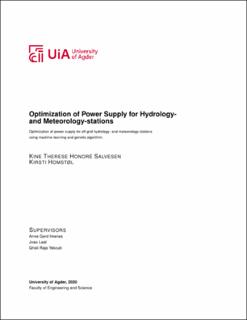| dc.contributor.author | Salvesen, Kine Therese Honoré | |
| dc.contributor.author | Homstøl, Kirsti | |
| dc.date.accessioned | 2020-03-09T09:10:59Z | |
| dc.date.available | 2020-03-09T09:10:59Z | |
| dc.date.issued | 2019 | |
| dc.identifier.uri | https://hdl.handle.net/11250/2645945 | |
| dc.description | Master's thesis Renewable Energy ENE500 - University of Agder 2019 | en_US |
| dc.description.abstract | This thesis consider a case study of a PV/wind/battery hybrid energy system installed at Scanmatic ASheadquarters in Arendal, Norway. The energy system is a stand-alone and off-grid hybrid system. It consistof four PV panels of 20 W with different tilt and orientation, a wind turbine of 300 W and a battery of1.4 kWh. This work consider machine learning and artificial intelligence in Python 3 for prediction andoptimization. Machine learning is used to predict the power production from the system components basedon the weather data at site. Artificial intelligence is used to optimize the system size based on cost and theability to produce sufficient power to the load.Five ANN models are build, one for each of the PV panels and one for the wind turbine. The models aretrained and evaluated with the data collected through the case study. The performance of each model areevaluated using multiple evaluation metrics to gain an overall knowledge of the models. The results con-clude that all of the models have an ability to predict the power production for the corresponding component,to a varying extend, and with a tendency to underpredict.A genetic algorithm is implemented to optimize the hybrid system. The objective function of the GA is tominimize the total system cost while always meeting the load demand. The evaluation of the results fromthe GA show that the algorithm has the ability to optimize the system within given constraints. The GA issimulated for multiple scenario to see how the system performs under different test conditions. The resultsof the simulation of the GA conclude that for all the scenarios the optimized system include PV panels andbattery, but do not include a wind turbine. | en_US |
| dc.language.iso | eng | en_US |
| dc.publisher | Universitetet i Agder ; University of Agder | en_US |
| dc.rights | Attribution-NonCommercial-NoDerivatives 4.0 Internasjonal | * |
| dc.rights.uri | http://creativecommons.org/licenses/by-nc-nd/4.0/deed.no | * |
| dc.subject | ENE500 | en_US |
| dc.title | Optimization of Power Supply for Hydrology-and Meteorology-stations : Optimization of power supply for off-grid hydrology- and meteorology-stationsusing machine learning and genetic algorithm | en_US |
| dc.type | Master thesis | en_US |
| dc.subject.nsi | VDP::Teknologi: 500::Elektrotekniske fag: 540::Elkraft: 542 | en_US |
| dc.subject.nsi | VDP::Teknologi: 500::Informasjons- og kommunikasjonsteknologi: 550 | en_US |
| dc.source.pagenumber | 141 p. | en_US |

